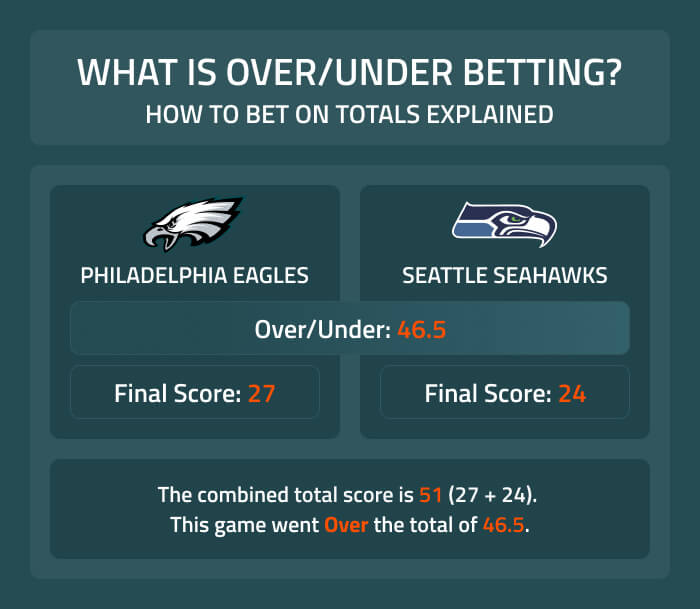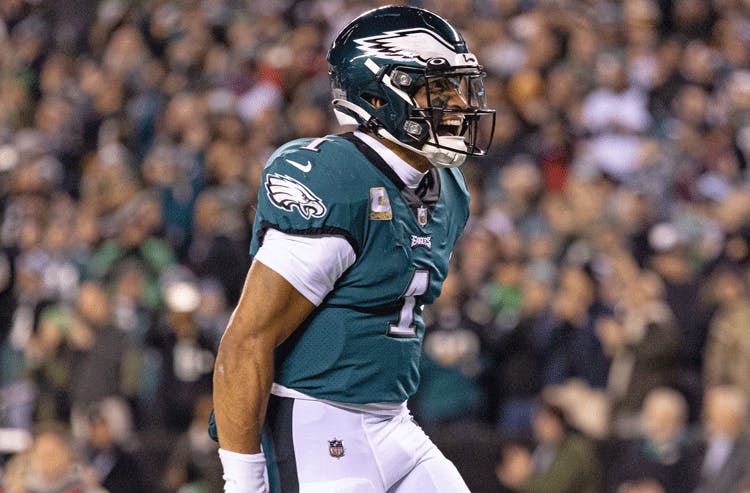What does Over/Under mean?
The Over/Under is a set of odds in which you bet on whether the combined score will add up to more or less than the projected total number set by oddsmakers.
If you believe there will be more points scored than the projected total, you would bet the Over. If you believe there will be fewer points scored than the projected total, you would bet the Under.
Over/Under betting, or totals betting, is one of the most popular options for sports bettors along with the point spread and moneyline.
Total bets are simply based on the number of points scored, without any link to the outcome of the game. Over/Under betting is found in almost all sports, including the NFL, college football, NBA, MLB, and NCAA basketball.

Over/Under betting explained
Let’s look at the betting total from Super Bowl LIV as an example of how to read Over/Under odds.
Super Bowl Over/Under

Based on these odds, the Over/Under for Super Bowl LIV between the Kansas City Chiefs and the San Francisco 49ers was 53 points. Each side of the total – the Over and Under – is assigned a cost of placing that bet, also known as juice or vig. The vig for most Over/Under bets is -110 on each side, which means in order to win $100 betting on the Over or the Under you would need to wager $110.
Kansas City won Super Bowl LIV by a final score of 31-20, with 51 total points scored by both teams. That means the Super Bowl went Under the projected total of 53 points. Anyone who bet on the Under 53 won their bets while anyone who bet the Over 53 lost.
How to bet the Over/Under
Before making an Over/Under bet, you’ll need to decide if the collective score will be more or less than the oddsmakers’ total and if you should make the bet now or later — because the Over/Under might change. Then you’ll want to understand the vig/juice on the total and how much you stand to win.
NBA Over/Under

In this example, the total for this game between the L.A. Clippers and L.A. Lakers is set at 222.5 points with the vig on both the Over and Under set at -110.
Oddsmakers will often use half points when setting Over/Under totals, which means there is no chance for the final score to land directly on the projected total.
If you bet the Over you would be predicting 223 points or more and if you bet the Under you would be predicting 222 points or less.
MLB Over/Under

Looking at the MLB, the betting total for this game between the Washington Nationals and Los Angeles Dodgers is set at 7.5 runs. However, the Over has a vig of -120 while the Under is set at +100 or EVEN money.
This difference in the vig could be because there is a slightly higher probability that the final score totals eight runs or more. It could also reflect the amount of money already wagered on the Over, as sportsbooks attempt to entice bets on the Under at the lower vig to balance out the money on either side.
If you bet the Over, you would be predicting eight runs or more and would need to wager $120 to win $100. If you bet the Under, you would be predicting seven runs or less and would win $100 if you wagered $100.
What is the payout on an Over/Under bet?
Most Over/Under bets have a vig of -110 on both the Over and Under. This is also known as a flat rate. That means that for every $100 you wish to win you must wager $110 – or a payout of 91 cents for every $1 wagered.
Sometimes sportsbooks will adjust the vig on the Over/Under to entice more money to be wagered on one side. If a book has taken a lot of money on the Over 53 (-110) and little money on the Under 53 (-110), then they may change the vig to Over 53 (-115)/Under 53 (-105).
This gives the Under a better payout (95 cents for every $1 wagered on Under compared to 87 cents on every $1 wagered on Over) and induces action on the Under, balancing the money bet on either side of the Over/Under and ensuring a profit for the sportsbook regardless of the result.
Use our Over/Under betting calculator to see how much money you can win with your totals bet.
How is the Over/Under determined?
Oddsmakers take many factors into consideration when setting the Over/Under total, beyond the basic offensive and defensive stats of the teams involved.
Weather can have a significant influence on scoring production in outdoor sports like football and baseball, with wind serving as the most impactful conditions. Lineups, injuries, coaching plans, home and away results, and scheduling will also be measured by oddsmakers when setting Over/Under odds.
The amount of money bet on the Over or the Under can also determine the total. If more money is being wagered on the Over, sportsbooks may increase the total to entice betting on the Under. If more money is being wagered on the Under, sportsbooks may decrease the total to draw money on the Over.
Over/Under FAQs
If the score equals the Over/Under betting total exactly, the bet is graded as a push and wagers are returned.
Most Over/Under bets do include overtime unless specified by the sportsbook.
Total is another term for Over/Under odds, betting on the total combined score.
Betting totals do not often use 3-way bets. They are most commonly used for moneyline betting in soccer, with odds on each team as well as a draw match.
Betting on even money, meaning you stand to win the same amount you bet, can be attractive for a few reasons. Firstly, even money bets typically represent events that have about a 50/50 chance of happening, often making them easier to predict than other types of bets. Secondly, these bets can be a solid part of a long-term betting strategy, as consistent wins can compound over time. Lastly, such bets can be less risky, as potential losses are the same as the possible gains. However, as with all betting, understanding the event and the teams or players involved is crucial to making a good bet.




















